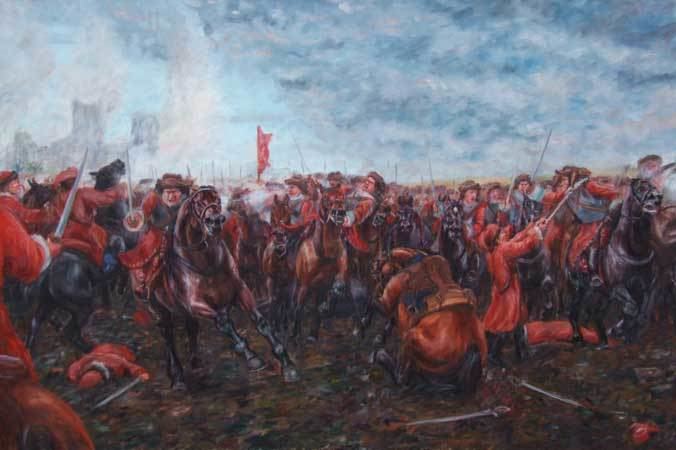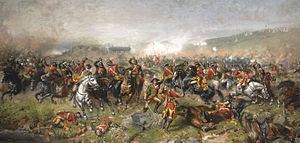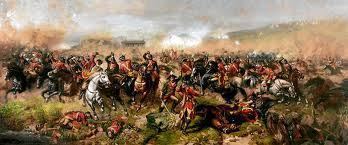18,000 20,000 Date 12 July 1691 | 4,000 killed and 3-4,000 captured or missing 3,000 killed Result Williamite victory | |
 | ||
Similar | ||
Battle of aughrim celtic guitar traditional irish music
The Battle of Aughrim (Irish: Cath Eachroma) was the decisive battle of the Williamite War in Ireland. It was fought between the Jacobites and the forces of William III on 12 July 1691 (old style, equivalent to 22 July new style), near the village of Aughrim, County Galway.
Contents
- Battle of aughrim celtic guitar traditional irish music
- The battle of aughrim the chieftains with chet atkins
- The campaign
- The Battle
- Aftermath
- Aughrim Interpretative Centre
- References

The battle was one of the more bloody recorded fought on Irish soil – over 7,000 people were killed. It meant the effective end of Jacobitism in Ireland, although the city of Limerick held out until the autumn of 1691.

The battle of aughrim the chieftains with chet atkins
The campaign

The Jacobite position in the summer of 1691 was a defensive one. In the previous year, they had retreated behind the River Shannon, which acted as an enormous moat around the province of Connacht, with strongholds at Sligo, Athlone and Limerick guarding the routes into Connacht. From this position, the Jacobites hoped to receive military aid from Louis XIV of France via the port towns and eventually be in a position to re-take the rest of Ireland.

Godert de Ginkell, the Williamites' Dutch general, had breached this line of defence by crossing the Shannon at Athlone - taking the town after a bloody siege. The Marquis de St Ruth (General Charles Chalmont), the French Jacobite general, moved too slowly to save Athlone, as he had to gather his troops from their quarters and raise new ones from rapparee bands and the levies of Irish landowners. Ginkel marched through Ballinasloe, on the main road towards Limerick and Galway, before he found his way blocked by St Ruth’s army at Aughrim on the 12th of July 1691. Both armies were about 20,000 men strong. The soldiers of St Ruth’s army were mostly Irish Catholic, while Ginkel's were English, Scottish, Danish, Dutch and French Huguenot (members of William III’s League of Augsburg) and Irish Protestants.

The Jacobite position at Aughrim was quite strong. St Ruth had drawn up his infantry along the crest of a ridge known as Kilcommadan Hill. The hill was lined with small stone walls and hedgerows which marked the boundaries of farmers' fields, but which could also be improved and then used as earthworks for the Jacobite infantry to shelter behind. The left of the position was bounded by a bog, through which there was only one causeway, overlooked by Aughrim village and a ruined castle. On the other, open, flank, St Ruth placed his best infantry under his second-in-command, the chevalier de Tessé, and most of his cavalry under Patrick Sarsfield.
The Battle
The battle started with Ginkel trying to assault the open flank of the Jacobite position with cavalry and infantry. This attack ground to a halt after determined Jacobite counter-attacks and the Williamites halted and dug in behind stakes driven into the ground to protect against cavalry. The French Huguenot forces committed here found themselves in low ground exposed to Jacobite fire and took a great number of casualties. Contemporaneous accounts speak of the grass being slippery with blood. To this day, this area on the south flank of the battle is known locally as the "Bloody Hollow". In the centre, the Williamite infantry under Hugh Mackay tried a frontal assault on the Jacobite infantry on Kilcommadan Hill. The Williamite troops, mainly English and Scots, had to take each line of trenches, only to find that the Irish had fallen back and were firing at them from the next line. The Williamite infantry attempted three assaults, the first of which penetrated furthest. Eventually, the final Williamite assault was driven back with heavy losses by cavalry and pursued into the bog, where more of them were killed or drowned. In the rout, the pursuing Jacobites manage to spike a battery of Williamite guns.
This left Ginkel with only one option, to try to force a way through the causeway on the Jacobite left. This should have been an impregnable position, with the attackers concentrated into a narrow lane and covered by the defenders of the castle there. However, the Irish troops there were short on ammunition. Mackay directed this fourth assault, consisting mainly of cavalry, in two groups - one along the causeway and one parallel to the south. The Jacobites stalled this attack with heavy fire from the castle, but then found that their reserve ammunition, which was British-made, would not fit into the muzzles of their French-supplied muskets. The Williamites then charged again with a reasonably fresh regiment of Anglo-Dutch cavalry under Henri de Massue. Faced with only weak musket fire, they crossed the causeway and reached Aughrim village with few casualties. A force of Jacobite cavalry under Henry Luttrell had been held in reserve to cover this flank. However, rather than counterattacking at this point, their commander ordered them to withdraw, following a route now known locally as "Luttrell's Pass". Henry Luttrell was alleged to have been in the pay of the Williamites and was assassinated in Dublin after the war. The castle quickly fell and its Jacobite garrison surrendered.
"[The] fire from the castle on the right. . . was insignificant for it slew but a few in the passage. The reason of it was given because the men had French pieces, the bore of which was small and had English ball which was too large."
The Jacobite general Marquis de St Ruth, after the third infantry rush on the Williamite position up to their cannons, appeared to believe that the battle could be won and was heard to shout, "they are running, we will chase them back to the gates of Dublin". However, as he tried to rally his cavalry on the left to counter-attack and drive the Williamite horse back, he was decapitated by a cannonball. At this point, the Jacobite position collapsed very quickly. Their horsemen, demoralised by the death of their commander, fled the battlefield, leaving the left flank open for the Williamites to funnel more troops into and envelope the Jacobite line. The Jacobites on the right, seeing the situation was hopeless, also began to melt away, although Sarsfield did try to organise a rearguard action. This left the Jacobite infantry on Killcommadan Hill completely exposed and surrounded. They were slaughtered by the Williamite cavalry as they tried to get away, many of them having thrown away their weapons in order to run faster. One eyewitness, George Storey, said that bodies covered the hill and looked from a distance like a flock of sheep.
Aftermath
Estimates of the two armies' losses vary. It is generally agreed that about 5–7,000 men were killed at the battle. Some recent studies put the Williamite dead as high as 3,000, but they are more generally given as between 1-2,000, with 4,000 Jacobites killed. However the Williamite death toll released by them at the time was only 600 and they claimed to have killed fully 7,000 Jacobites. Many of the Jacobite dead were officers, who were very difficult to replace. On top of that, another 4,000 Jacobites either deserted or were taken prisoner. What was more, they had lost the better part of their equipment and supplies.
For these reasons, Aughrim was the decisive battle of the Williamite war in Ireland. The city of Galway surrendered without a fight after the battle, on advantageous terms, and the Jacobites' main army surrendered shortly afterwards at Limerick after a short siege. The battle, according to one author, "seared into Irish consciousness", and became known in the Irish language tradition as Eachdhroim an áir - "Aughrim of the slaughter". The contemporary Gaelic poet Séamas Dall Mac Cuarta wrote of the Irish dead, "It is at Aughrim of the slaughter where they are to be found, their damp bones lying uncoffined". Another poet wrote, "Our friends in vast numbers and languishing forms, left lifeless in the mountains and corroded by worms". In 1885, Artist John Mulvany completed his painting of this battle. It was exhibited at the Gorry Gallery In Dublin, Ireland in 2010.
Since it marked the end of the Irish Catholic Jacobite resistance, Aughrim was the focus of Loyalist (particularly Orange Order) celebrations in Ireland on 12 July up until the early 19th century. Thereafter, it was superseded by the Battle of the Boyne in commemorations on "the Twelfth" due to the switch to the Gregorian calendar (in which 1 July OS became 11 July NS and 12 July OS became 22 July NS). It has also been suggested that the Boyne was preferred because the Irish troops there were more easily presented as cowardly than at Aughrim, where they generally fought bravely.
It is also mentioned in "The Sash", an Ulster folksong:
It is old but it is beautiful, and its colours they are fine
It was worn at Derry, Aughrim, Enniskillen and the Boyne.
My father wore it as a youth in bygone days of yore,
And on the Twelfth I love to wear the sash my father wore.
The Aughrim battlefield site became the subject of controversy in Ireland over plans to build the new M6 motorway through the former battlefield. Historians, environmentalists and members of the Orange Order objected to the destruction of the 1691 battlefield. The motorway opened in 2009.
Aughrim Interpretative Centre
The Battle of Aughrim Interpretative Centre, situated in Aughrim Village was opened in 1991. It is a collaboration between Aughrim Heritage Committee, Ireland West Tourism, and Galway County Council. It houses artifacts gathered up from the battlefield site as well as three-dimensional displays. There is also a documentary film that explains the course of the battle and its significance in the wider context of the history of Ireland
